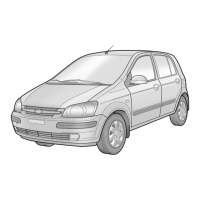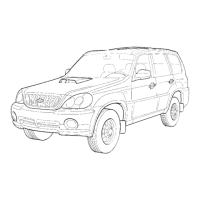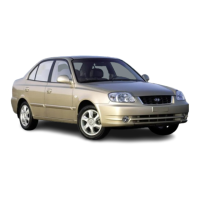Do you have a question about the Hyundai 2004 Accent and is the answer not in the manual?
Details the limited warranty for the new vehicle covering 60 months or 60,000 miles.
Covers the powertrain for the original owner for 120 months or 100,000 miles.
Warranty related to emission control systems for federal vehicles.
Explains how to operate various features and systems of the vehicle.
Covers the required maintenance procedures and schedules for the vehicle.
Provides detailed technical specifications for the vehicle's components.
Explains the meaning of various warning lights and indicators on the instrument panel.
Details the function and potential issues indicated by dashboard warning lights.
Provides guidance on the correct type of fuel and additives for the vehicle.
Offers recommendations for the initial period of vehicle operation to ensure durability.
Explains how to lock and unlock vehicle doors, including keyless entry and child protection.
Provides instructions and safety guidelines for installing and using child safety seats.
Details the proper use, precautions, and adjustment of seat belts for occupant safety.
Explains the operation and safety features of the dual-stage airbag system.
Describes the various gauges, indicators, and warning lights on the instrument cluster.
Covers the operation of the vehicle's climate control system, including ventilation and air conditioning.
Explains the operation of the stereo radio, cassette player, and compact disc player.
Outlines essential checks and procedures to perform before starting the vehicle's engine.
Describes the different positions of the ignition key cylinder and their functions.
Explains the correct procedure for starting the vehicle's engine and ignition system.
Details how to operate the manual transmission, including shift points and clutch usage.
Explains the operation of the automatic transmission, including gear selection and shift lock release.
Provides advice on safe and effective braking techniques to ensure vehicle control.
Explains the function and operation of the Anti-Lock Brake System (ABS) for improved safety.
Offers tips on how to drive efficiently to save fuel and reduce operating costs.
Provides guidance and precautions for driving the vehicle in winter conditions.
Provides troubleshooting steps for situations where the engine fails to start.
Explains the procedure and safety precautions for jump-starting a discharged battery.
Outlines steps to take if the vehicle's engine overheats, including safety warnings.
Details the step-by-step process for safely changing a flat tire, including tool usage.
Provides instructions and precautions for towing the vehicle safely.
Offers guidance on what to do if the vehicle's keys are lost or locked inside.
Explains common causes of corrosion and how to protect the vehicle.
Provides instructions for washing, drying, and waxing the vehicle's exterior.
Offers guidance on cleaning the vehicle's interior, including upholstery, carpets, and windows.
Outlines the recommended service intervals for various maintenance tasks.
Lists scheduled maintenance services and their required frequencies based on mileage and time.
Details maintenance items that require more frequent service under severe driving conditions.
Explains the purpose and procedure for specific scheduled maintenance items.
Identifies key components and fluid reservoirs located in the engine compartment.
Provides instructions on how to check and add engine oil, including recommended types.
Details the procedure for changing the engine oil and filter, including safety precautions.
Explains how to replace spark plugs, including recommended types and tools.
Covers checking brake fluid level and recommended fluid types, with safety warnings.
Guides on how to adjust headlight aim for optimal visibility and compliance with standards.
Provides instructions for replacing various exterior and interior light bulbs.
Details the location and function of fuses in the engine compartment and inner panel fuse boxes.
Describes the vehicle's emission control systems and the importance of proper maintenance.
Explains the function of the catalytic converter and precautions for its operation and maintenance.
Explains the importance and locations of the Vehicle Identification Number (VIN).
Details the Department of Transportation's quality grades for tires (Treadwear, Traction, Temperature).
Outlines the different limited warranties provided with the Hyundai vehicle.
Provides information on how to report safety defects to NHTSA and Hyundai.
Lists key physical dimensions of the vehicle for both 4-door and 3-door models.
Provides specifications for tire sizes and recommended inflation pressures.
Details specifications for the power steering system, including type and fluid.
Lists detailed engine specifications, including type, displacement, and spark plug information.
Details the recommended types and capacities of oils and fluids for various vehicle components.
Details the limited warranty for the new vehicle covering 60 months or 60,000 miles.
Covers the powertrain for the original owner for 120 months or 100,000 miles.
Warranty related to emission control systems for federal vehicles.
Explains how to operate various features and systems of the vehicle.
Covers the required maintenance procedures and schedules for the vehicle.
Provides detailed technical specifications for the vehicle's components.
Explains the meaning of various warning lights and indicators on the instrument panel.
Details the function and potential issues indicated by dashboard warning lights.
Provides guidance on the correct type of fuel and additives for the vehicle.
Offers recommendations for the initial period of vehicle operation to ensure durability.
Explains how to lock and unlock vehicle doors, including keyless entry and child protection.
Provides instructions and safety guidelines for installing and using child safety seats.
Details the proper use, precautions, and adjustment of seat belts for occupant safety.
Explains the operation and safety features of the dual-stage airbag system.
Describes the various gauges, indicators, and warning lights on the instrument cluster.
Covers the operation of the vehicle's climate control system, including ventilation and air conditioning.
Explains the operation of the stereo radio, cassette player, and compact disc player.
Outlines essential checks and procedures to perform before starting the vehicle's engine.
Describes the different positions of the ignition key cylinder and their functions.
Explains the correct procedure for starting the vehicle's engine and ignition system.
Details how to operate the manual transmission, including shift points and clutch usage.
Explains the operation of the automatic transmission, including gear selection and shift lock release.
Provides advice on safe and effective braking techniques to ensure vehicle control.
Explains the function and operation of the Anti-Lock Brake System (ABS) for improved safety.
Offers tips on how to drive efficiently to save fuel and reduce operating costs.
Provides guidance and precautions for driving the vehicle in winter conditions.
Provides troubleshooting steps for situations where the engine fails to start.
Explains the procedure and safety precautions for jump-starting a discharged battery.
Outlines steps to take if the vehicle's engine overheats, including safety warnings.
Details the step-by-step process for safely changing a flat tire, including tool usage.
Provides instructions and precautions for towing the vehicle safely.
Offers guidance on what to do if the vehicle's keys are lost or locked inside.
Explains common causes of corrosion and how to protect the vehicle.
Provides instructions for washing, drying, and waxing the vehicle's exterior.
Offers guidance on cleaning the vehicle's interior, including upholstery, carpets, and windows.
Outlines the recommended service intervals for various maintenance tasks.
Lists scheduled maintenance services and their required frequencies based on mileage and time.
Details maintenance items that require more frequent service under severe driving conditions.
Explains the purpose and procedure for specific scheduled maintenance items.
Identifies key components and fluid reservoirs located in the engine compartment.
Provides instructions on how to check and add engine oil, including recommended types.
Details the procedure for changing the engine oil and filter, including safety precautions.
Explains how to replace spark plugs, including recommended types and tools.
Covers checking brake fluid level and recommended fluid types, with safety warnings.
Guides on how to adjust headlight aim for optimal visibility and compliance with standards.
Provides instructions for replacing various exterior and interior light bulbs.
Details the location and function of fuses in the engine compartment and inner panel fuse boxes.
Describes the vehicle's emission control systems and the importance of proper maintenance.
Explains the function of the catalytic converter and precautions for its operation and maintenance.
Explains the importance and locations of the Vehicle Identification Number (VIN).
Details the Department of Transportation's quality grades for tires (Treadwear, Traction, Temperature).
Outlines the different limited warranties provided with the Hyundai vehicle.
Provides information on how to report safety defects to NHTSA and Hyundai.
Lists key physical dimensions of the vehicle for both 4-door and 3-door models.
Provides specifications for tire sizes and recommended inflation pressures.
Details specifications for the power steering system, including type and fluid.
Lists detailed engine specifications, including type, displacement, and spark plug information.
Details the recommended types and capacities of oils and fluids for various vehicle components.
| Brand | Hyundai |
|---|---|
| Model | 2004 Accent |
| Category | Automobile |
| Language | English |











